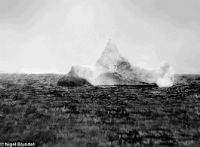 The headlines are great. “Iceberg that Sank the Titanic 100,000 years old” and “Titanic iceberg was a 100,000-year-old giant” and “Iceberg that sank the Titanic was 100,000-years-old and of monstrous size” and so and so on. Dozens of headlines and all are variations on the same theme. It must be true because so many news outlets are repeating it! Or maybe not.
The headlines are great. “Iceberg that Sank the Titanic 100,000 years old” and “Titanic iceberg was a 100,000-year-old giant” and “Iceberg that sank the Titanic was 100,000-years-old and of monstrous size” and so and so on. Dozens of headlines and all are variations on the same theme. It must be true because so many news outlets are repeating it! Or maybe not.
This ancient berg frenzy was apparently set off by a recent study by Grant Bigg, professor of earth system science at Sheffield University, whose team has been tracking the paths of icebergs. They chose to model the path of the iceberg with which the Titanic had its unfortunate meeting in 1912. Apparently the scientists said that the iceberg came from a glacier formed by snow which fell “over 100,000 years ago.” Viola, a hundred-year-old iceberg is born.
The problem is that snowfall does not an iceberg make. Snow does, over time, create a glacier and glaciers eventually calve to cause icebergs, but claiming that very old snow establishes the age of an iceberg is a rather heroic reach. The scientists estimate that the berg calved from the glacier around 1908. So this particular block of large and dangerous ice began drifting toward its rendezvous with the Titanic only four years before the collision.
When does an iceberg become an iceberg? It seems reasonable to me that until it calves from the glacier, it is, well, just part of the glacier. By this standard, rather than 100,000 years old, four years old seems like a better estimate of the age of the Titanic’s nemesis.
The iceberg was also apparently considerably larger when it calved from the Greenland glacier, but melted considerably before it met the Titanic. It was, nevertheless, still large enough to sink the ship.

Has anyone ever played around with the question of whether the Titanic iceberg tangled with any other shipping, either before or after?
And how old were its water molecules?
Pingback: Travel News / Did a 100,000 Year Old Iceberg Sink the Titanic? Or Perhaps a 4 Year Old Iceberg?
One cannot but be reminded of Thomas Hardy’s poem about the disaster. “The Convergence of the Twain”:
I
In a solitude of the sea
Deep from human vanity,
And the Pride of Life that planned her, stilly couches she.
II
Steel chambers, late the pyres
Of her salamandrine fires,
Cold currents thrid, and turn to rhythmic tidal lyres.
III
Over the mirrors meant
To glass the opulent
The sea-worm crawls — grotesque, slimed, dumb, indifferent.
IV
Jewels in joy designed
To ravish the sensuous mind
Lie lightless, all their sparkles bleared and black and blind.
V
Dim moon-eyed fishes near
Gaze at the gilded gear
And query: “What does this vaingloriousness down here?” …
VI
Well: while was fashioning
This creature of cleaving wing,
The Immanent Will that stirs and urges everything
VII
Prepared a sinister mate
For her — so gaily great —
A Shape of Ice, for the time far and dissociate.
VIII
And as the smart ship grew
In stature, grace, and hue,
In shadowy silent distance grew the Iceberg too.
IX
Alien they seemed to be;
No mortal eye could see
The intimate welding of their later history,
X
Or sign that they were bent
By paths coincident
On being anon twin halves of one august event,
XI
Till the Spinner of the Years
Said “Now!” And each one hears,
And consummation comes, and jars two hemispheres.